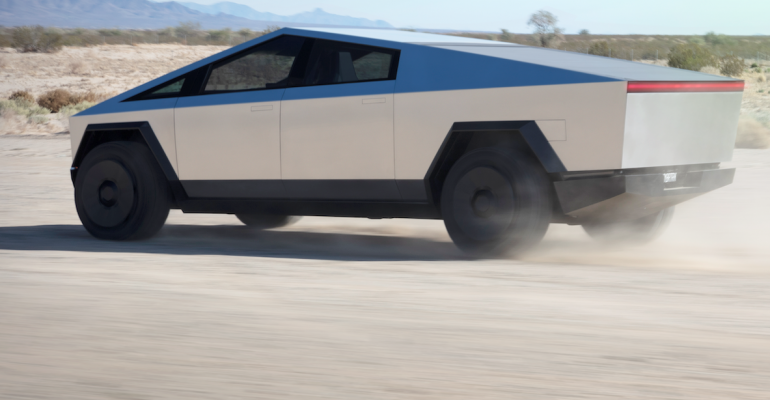When I first saw Tesla’s Cybertruck my immediate reaction was, “What the?” But my second reaction was, “Wow, that’s brilliant!”
Here’s what changed my mind and why the auto industry should pay close attention to what Tesla did.
All the body panels on the Cybertruck are completely flat, and all the feature lines look like they were drawn with a ruler and T-square. There’s not one curve anywhere to be seen. It’s a truck that looks like it could have been made in a high school shop class.
Critics had a field day, ripping into the simplistic, origami-like design. But they missed a crucial point of why this truck looks the way it does: The payoff is Tesla can eliminate most of the tooling costs.
With the flat panels and straight lines, the automaker doesn’t need stamping dies to shape the body panels, or even blanking dies to form steel blanks. They can waterjet or laser-cut the panels to size and even cut out the window openings this way.
Other standard tooling such as hemming dies won’t be necessary either. All Tesla will need is a simple break press to crease and fold the panels to the proper shape.
The body is an exoskeleton, which is to say, the body panels are welded together to form the structure of the truck. This is not body-on-frame construction like a conventional pickup truck, nor a collection of panels bolted and welded into a unitized body shell like a typical car or crossover. Instead, it’s a different way of constructing a vehicle, which no other major automaker has ever done.
Sandy Munro of Munro & Associates, an expert in competitive benchmarking, estimates Tesla will save $60 million by eliminating blanking and stamping dies compared with traditional ways of making trucks. Keep in mind that he calculated this for a 50,000 unit-a-year run.
While Tesla has not disclosed its production targets for the Cybertruck, it’s likely it will start out in low volume. This eliminates the need for an automated body shop. Munro says Tesla could use manual-load, auto-clamp fixtures to hold the panels, manually tack them together, then TIG weld the structure.
Just as importantly, the body panels are made from stainless steel. In fact, it’s the same type of stainless steel (ultra-hard 30X cold-rolled) that Elon Musk is using to make the SpaceX Starship rocket that he plans to send to Mars. What a marketing tie-in!
Like the stainless-steel DeLorean sports car from 40 years ago, Tesla is not going to paint the bodies. Not only does that eliminate the cost of the paint, it also eliminates the need for a paint shop, which is extremely expensive.
A typical high-volume paint shop in an assembly plant costs half a billion dollars. Even a low-volume paint shop can cost $150 million. Moreover, paint shops require a battery of environmental permits before they can be built. They take up an enormous amount of room, have expensive pollution control equipment and must be maintained at cleanroom levels of cleanliness. Plus, they are very energy- intensive because baking ovens are needed to dry the paint. Eliminating the paint shop results in a massive cost savings.
The flat glass in the truck also is much easier to manufacture, and flat glass is perfect for head-up-displays. The compound curves used on the windshields of all other vehicles require automakers to use complex optic controls for HUDs. Not so with the Cybertruck.
Put it all together and Munro estimates the total tooling cost for the Cybertruck will be about $30 million, which is nothing in automotive terms. If the truck were in production for five years, its tooling cost “economic burden” would only be $120 per truck. Compare that to an estimated $205 for a high-volume pickup such as the F-150.
In other words, the Cybertruck’s design eliminates the advantages of manufacturing scale its competitors have. And this is why Musk can claim the price will start at only $39,000.
The styling of the Cybertruck still is controversial. But give it time. Opinions about how it looks likely will change. When the late, great Syd Mead was asked what he thought of the truck, the renowned designer called it stylistically breathtaking and said that “it completely changed the vocabulary of the personal truck market design.”
 That’s quite a statement, and maybe a wake-up call for automakers who depend so heavily on their profit-laden pickups.
That’s quite a statement, and maybe a wake-up call for automakers who depend so heavily on their profit-laden pickups.
John McElroy is editorial director of Blue Sky Productions and producer of “Autoline Detroit” for WTVS-Channel 56, Detroit.





